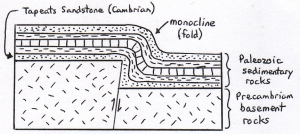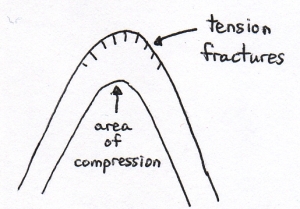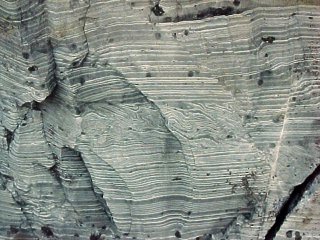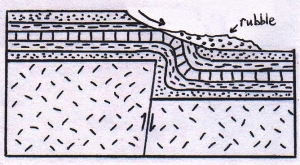| This is part six of a six-part series examining supposed evidences for a global flood that have recently appeared on the Answers in Genesis web site. |
| The people at AiG are my brothers and sisters in Christ, and I share their love for the Lord Jesus Christ, their respect for the Bible as the Word of God, and their desire to see people come to faith in Christ. However, I view their arguments for a young Earth and geological catastrophism as unnecessary Biblically, as poor apologetics, and as a serious obstacle to the evangelism of scientists. |
| Unfortunately, few people in our churches or Christian education system have the geological background to critically analyze these arguments. The result is that people read articles like these from AiG, find them to be rather impressive, and believe that these present sound arguments in defense of the Bible. The opposite, however, is true. A vast majority of Christian geologists find the arguments for a young Earth and the geologic work of the Flood to be untenable. It is my strong opinion that the young-Earth arguments of young-Earth creationist organizations like AiG have no place in our churches and Christian education system. |
| Part one examined the young-Earth creationist (YEC) argument that fossils at high elevations are proof of a global flood. |
| Part two examined the YEC argument that sedimentary rocks that contain dense accumulations of fossils can best be described by the action of Noah’s Flood. |
| Part three examined the YEC perception that transcontinental rock layers, such as the sandstone layer that is found at the base of the Paleozoic sediments throughout much of North America, can best be explained by Noah’s flood. |
| Part four looked at the YEC claim that long-distance transport of sand grains can only be explained by Noah’s flood. |
| Part five looked at unconformities and the boundaries between geological formations. The young-Earth crowd claims that there is no evidence for weathering and erosion between layers, which is simply not true. |
“Flood evidence number six” from Answers in Genesis is called “Rock Layers Folded, Not Fractured.”
This final article in Andrew Snelling’s six-part series on geology and the flood begins with another incredible mis-statement:
“How could a series of sedimentary layers fold without fracturing? The only way is for all the sedimentary layers to be laid down in rapid succession and then be folded while still soft and pliable.”

Snelling, who has a PhD in geology and is the director of the research department at Answers in Genesis, seeks to demonstrate that the entire sedimentary rock record in the Grand Canyon was unlithified (i.e. soft) when later folding and faulting occurred. If so, according to Snelling, these rocks could not have been deposited over a period of hundreds of millions of years, and must have been deposited during Noah’s flood.
Snelling describes folding of rocks associated with the East Kaibab monocline, a structure in the Grand Canyon (Fig. 1). The Tapeats Sandstone, for example, has locally experienced intense folding where it has been deformed by faulting in the underlying Precambrian basement rocks. The Tapeats Sandstone is at the base of the Paleozoic rocks of the Grand Canyon; the overlying rocks have been deformed as well.
Snelling simplifies the situation by saying that there are only two options (a common young-Earth creationist tactic):
- If the rocks were solidified, then they would deform in a brittle fashion, characterized by faulting or shattering (Fig. 2).
- If the rocks were soft, then they would deform in a ductile (or plastic) fashion, characterized by folding.

Both of these statements are overgeneralizations to the point of being deceptive when used to make the young-Earth case.
The entire column of Paleozoic rocks at the locations described by Snelling is deformed by folding, so he concludes that the entire sequence of rocks must have been soft when deformed.
ANALYSIS
Snelling’s argument fails for several reasons.
1. First, Snelling has oversimplified the processes of rock deformation by stating that it is either ductile deformation of soft rocks, or plastic deformation of soft rocks. It is one thing to simplify a scientific concept for the sake of writing for a general audience, but Snelling has completely mislead his readers on this one.
Snelling states that only soft sediments are capable of ductile deformation; that soft sediments will deform like clay, while solid rocks are brittle and only capable of fracture. In reality, most solid rocks are capable of either brittle or ductile deformation, depending on the conditions. Factors that determine which will happen include the type of rock, the amount and type of stress applied to the rock; lithostatic pressure (due to the weight of overlying rocks), temperature, strain rate (fast or slow deformation), type of cement holding the grains together, and fluid pressure.
At low temperatures and pressures, such as those encountered at Earth’s surface, almost all rocks deform in a brittle manner. If one applies sufficient stress to these rocks, they will break. As one goes deeper in the Earth’s crust, temperature and pressure increases, and rocks are more likely to behave in ductile rather than a brittle fashion. Some rock types can deform by folding at depths of less than one kilometer if stress is applied slowly. With increasing depth and temperature, more rock types can deform by folding rather than faulting.
The Tapeats Sandstone is presently buried beneath up to two kilometers of sediment, and was likely buried more deeply than this at the time of deformation.
2. A second problem for Snelling’s argument is that there are a variety of mechanisms by which a solid rock can bend rather than break. Think of a layer of sandstone, such as the Tapeats Sandstone at the base of the Grand Canyon Paleozoic sedimentary pile. A layer such as this can be folded without significant fracturing by several means:
- Intergranular movement — individual sand grains slide past each other
- Intragranular deformation — internal distortions within individual grains, often at the atomic level
- Recrystallization — atoms are rearranged at the atomic level, often in the presence of fluids.
Snelling completely ignores these, even though any of them could have been in operation at the time of deformation.
3. A third—and very serious—problem for Snelling’s argument is the nature of soft-sediment deformation. He tries to show that intense folding in the Tapeats Sandstone is the result of soft-sediment deformation. But if the Tapeats and overlying formations had been soft at the time of deformation, soft-sediment deformation and slumping would have occurred on a much larger scale than what is seen at this location in the Grand Canyon.
When layers of solid rock deform, they maintain their integrity as distinct layers. For example, whether folded or faulted, the Redwall Limestone of the Grand Canyon retains its identity as a distinct layer, without mixing with other rock units. Soft sediments, on the other hand, can respond to stress in a number of ways. In addition to folding, a results of deformation of soft sediments includes different types of soft sediment deformation and differential loading structures, such as intense localized folding, diapirs, sand pillows, and clastic dikes (Fig. 3). These structures are formed because of the inherent instability of a stack of unconsolidated sediments of varying densities and water contents.



Figures 3A 3B 3C Credit: Dr. Steven Dutch, used by permission.
Soft sediment deformation structures are common within individual layers of the geologic column, having been formed when these layers were unlithified. For the young-Earth creationists to make their case, however, they need to be able to demonstrate that soft sediment deformation is present in the geologic record on a massive, inter-formational scale. It would not be enough to point out isolated instances of soft-sediment deformation within layers.

4. Related to the problem of soft-sediment deformation is the problem with slumping. If this stack of sediments—a few thousand meters thick—were faulted as in Figure 1, one would expect the upper layers to slide downhill under the influence of gravity (Figure 4). As a rule, this sort of thing is not observed in the geological record, and where it is (e.g. Heart Mountain, Wyoming) it clearly occurred in the solid state.
CONCLUSION
It is common for young-Earth creationists to state that the geological record can be easily explained by Noah’s flood. They say that most sedimentary rocks are best explained by global, catastrophic processes, and that the fossils these rocks contain represent the organisms that died in the year-long deluge. The geological field evidence, on the other hand, really does not fit the flood catastrophism model.
It must be emphasized that the Bible does not say that the sedimentary rock record was formed by Noah’s flood. Unlike Snelling, most Christian geologists (along with their non-Christian colleagues) look at the rock record and agree that it was formed by slower processes operating over a long period of time. This is not something that geologists read into the rock record, but something they read from the rock record.
The young-Earth creationist approach is to try to make the Earth fit a very rigid understanding of Genesis. The result is often like trying to force a square peg into a round hole; it can only be done by distorting either the peg or the hole (or both). The end result is that neither young-Earth science nor young-Earth Bible interpretation is believable. A better approach is the “all truth is God’s truth” approach. I start with the assumption that both the Bible and what God tells us through science is true. It is not wise to make one fit the other in an unnatural way. Does this lead to tension? A little, but not as much as either the young-Earth creationists or the atheists/skeptics would have you believe. We do not fully understand either science or the opening chapters of Genesis. When we do (not in this life, I suspect) then the tension will be gone.
With love for the body of Christ, and for those who are hindered from seeing the glory of Christ by bad apologetics.
==============================================
P.S. I felt I worded this much more succinctly as a comment on another blog:
————————————–
I’ve read the AiG article, and it just doesn’t work.
The question is whether folds were formed when the rocks were solid or unconsolidated. Other Christian geologists I know have pointed out that Snelling uses selective evidence in his study, as other parts of the same layers show very clear signs of solid-state deformation.
The way to see how solid rocks can bend is to take rocks and put them in a press in an engineering laboratory and see how they behave under stress. That has been done many times, and indeed you can do all sorts of things to rocks by putting pressure on them. In Earth’s crust, this results in the folds and faults that make up much of the world’s major mountain belts. These rocks show many signs of solid-state deformation.
If one applies the same sorts of pressure to layers of unconsolidated sediments (sand, silt, clay, etc.) the results are very different. Instead of getting folded layers of rocks, one gets chaos, with blobs of material distorting and either sinking or rising, depending on density. This is called soft-sediment deformation, and is readily distinguishable in the field from solid-rock deformation.
What is observed on a massive scale in the Earth’s crust (with some exceptions) is deformation of solid rocks, not soft-sediment deformation. If the bulk of the sedimentary rocks were laid down by Noah’s flood (and the Bible does not say that they were) then soft-sediment deformation on a massive scale should be a dominant feature of the sedimentary rocks, and it isn’t.
The “all sediments must have been laid down rapidly and while being soft” argument is not consistent with laboratory and field studies, and should not be used as Christian apologetics.
With respect,
Kevin N (Christian geologist)

I think I’ll have to do a blog post on the nature of apologetics at some point. When did apologetics shift to having to prove the entirely of the Bible as “true” in modern scientific terms?
I thought apologetics was meant to establish that the witness of the Church about Jesus is credible according to our internal beliefs, and then creating a bridge to people with differing beliefs (having established why we hold on to our own beliefs).
Apologetics now seems to be backwards, with our testimony about Jesus being lost in the shuffle. Now we assume the bridge is already built, cross it, burn it, and then beat people senseless with the planks in order to prove that our faith is right and their beliefs are wrong.
LikeLike
It bothers me that in so many of the YEC arguments they leave out pertinent details that go against their view or show a different light on the subject in question. I’m presuming they’re smart enough people to know these other details exist, yet the average Christian who reads their stuff has no idea that they’re doing it, which seems to amount to a form of deception in the guise of education/apologetics.
LikeLike
I’m sure Geochristian readers would love to hear that all six of Dr. Snelling’s arguments made it into The New Answers Book 3, almost word for word. The book just came out a week or two ago.
LikeLike
See also;
“Top Five” Reasons for Believing in a Young Earth (Part 1 of 6)
“Top Five” Reasons for Believing in a Young Earth (Part 2 of 6)
“Top Five” Reasons for Believing in a Young Earth (Part 3 of 6)
“Top Five” Reasons for Believing in a Young Earth (Part 4 of 6)
“Top Five” Reasons for Believing in a Young Earth (Part 5 of 6)
“Top Five” Reasons for Believing in a Young Earth (Part 6 of 6)
LikeLike
To wezlo – my opinion: the issue is whether the Bible can be taken seriously. The most straight-forward reading of Genesis indicates a young earth/universe, so that the world intuitively picks up on the fact that if the earth/universe is really billions of years old then the Bible is untenable right out of the gate. It starts off saying ‘In the beginning’, and proceeds to describe it rather tightly. If the description is not reliable at the first then you can toss the rest of the book, and testimony on the significance of Jesus along with it. Satan understands that dynamic, so he hammers on the issue, and has helped men construct the elaborate evolutionary story.
LikeLiked by 1 person
Ray:
There are many who take the Bible very seriously who do not see a requirement for a young Earth in its pages. Take a look at Notable Christians open to an old-universe, old-Earth perspective. The list could be much longer.
Thanks for your comment.
LikeLike
I somehow missed Frank’s comment back in April (I was traveling for three weeks back then). He points to Wile’s top five reasons for believing in a young Earth.
I recently had a dialog with Dr. Wile about his first reason, which is decaying planetary magnetic fields. Dr. Wile is a smart guy, but he doesn’t know geology. You can read the discussion on his blog: More Evidence Supporting The Young-Earth Theory of Earth’s Magnetic Field.
LikeLike
Pingback: Six bad answers to questions raised in Genesis are still six bad answers « Fr. Orthohippo
Pingback: The Forest Beyond Euphoria
Hi Geochristian. I just read your article on Kent Hovind. I couldn’t comment on there that’s why i’m commenting here. But anyway, I was confused at why a fellow “Christian” would tell people not to listen to him at all because of his tax issues and you don’t believe his theories are accurate. But then I read on, and I realized that you’re the one who seems confused. Why would you tell people to completely scratch off someone who is clearly just trying to lead people to Christ? He uses scripture to back up what he’s saying (your old world theory doesn’t) and he believes in a young earth which is a pretty common belief amongst Christians. If you choose to dismiss what someone says because they have made bad decisions in their lifetimes then nothing I say, you say, or what any other Chirstian says should be believed! We’ve all made terrible decisions in our lifetimes, I know I have. I truly believe that in order to come to the conclusion that the Earth is old you are misleading people and you’re misinterpreting the Bible. I have a hard time believing that this is the only thing from the Bible you are twisting . It says 6 days, it’s not a secret code, a theory, a suggestion, or a metaphor. The world was made in 6 days, that’s it, nothing more! I’m sure God knows what a day is, he said 6 days, he meant 6 days . I also read a comment you wrote on here about when you talked to a young earth creationist and you said, “he’s a smart guy but he doesn’t know anything about geology.” The Bible is written in a way that is understandable to people that do not have a background in geology or any other science. You don’t NEED to know geology to understand the creation of our world in 6 days. We have the Bible :)
LikeLiked by 1 person
Rachel,
I’m sorry I had to close the comments on the Kent Hovind post, but if I felt that the conversation was going nowhere so I put a stop to it.
I rejoice that Kent Hovind has led people to Christ, even if I disagree with his position on the age of the Earth or his politics. However, I am also saddened that much of what he teaches actually drives other people away from Christ.
When he uses “scientific” arguments that even other young-Earth creationists say are bogus, he does two things. First, he sets up an unnecessary barrier to scientifically-minded people who might otherwise be open to the gospel. Second, he sets up young people for a fall. When they base their faith on faulty evidence, they could (and do) fall away from their faith when they see that much of what “Dr” Dino tells them just isn’t true.
I admit that I could be wrong, but I don’t think the Bible requires a young Earth. For example, Genesis 1:1 (“In the beginning God created the heavens and the earth) is not necessarily part of the six days. In terms of how Genesis 1 is laid out, it could just as easily be a summary of the entire passage or something that happened before the six days. Also note that there are other figurative elements in the text. For instance, God’s work is not the same as our work, and God’s rest is not the same as our rest, so it could be that God’s days are not the same as our days.
There have been many Christians who advocate acceptance of an old Earth for biblical as well as scientific reasons, such as C.S. Lewis, Francis Schaeffer, John Piper, Charles Spurgeon, and many others. As an old-Earth Christian, I am in good company. I encourage you to read some of my GeoScriptures blog posts to read more about the biblical case for an old earth.
If you are going to be a young-Earth creationist, I suggest that you stick to the mainstream creationist organizations such as Answers in Genesis or the Institute for Creation Research. I disagree with much of what they teach, but they have well-qualified scientists who avoid many of the Dr. Dino-type arguments. I strongly discourage people from using Kent Hovind materials to educate their children.
Kevin Nelstead
LikeLike
Kevin:
Thanks for the great blog, the great attitude, and the great information. My kids are currently studying science from a YEC perspective. I don’t plan to make waves, even though I disagree with it. However, I will challenge them to be good “Bereans” and look critically, referencing all sources, rather than just being spoon-fed YEC information.
LikeLike
“It must be emphasized that the Bible does not say that the sedimentary rock record was formed by Noah’s flood. Unlike Snelling, most Christian geologists (along with their non-Christian colleagues) look at the rock record and agree that it was formed by slower processes operating over a long period of time. This is not something that geologists read into the rock record, but something they read from the rock record.”
See, the problem with this, is NEITHER side has observed almost ANY formation of sediment over any time scale. Which is why this argument is wrong. Everyone reads it that way but also no one has ever observed it, either, so the argument by majority is baseless. We don’t know how to properly read something we haven’t seen processed.
LikeLike
bmx0 – This is not true. Geologists have observed the deposition of sedimentary deposits in both the lab and in the field. There are a number of sedimentary environments, such as deltas, braided streams, meandering streams, beaches, barrier islands, continental shelves, reefs, deserts, and glaciers. Sediments deposited in these settings have certain characteristics, which may be observed in modern environments as well as in ancient rocks. Some of these features, such as reefs (complete with fore reef, reef core, and back reef) are difficult, if not impossible, to explain in the young-Earth scenario.
LikeLike
Very nicely done.
Thanks for this resource. In contrast, I write lies. There is a lot less research required.
https://oldmenandinfidels.com
LikeLike